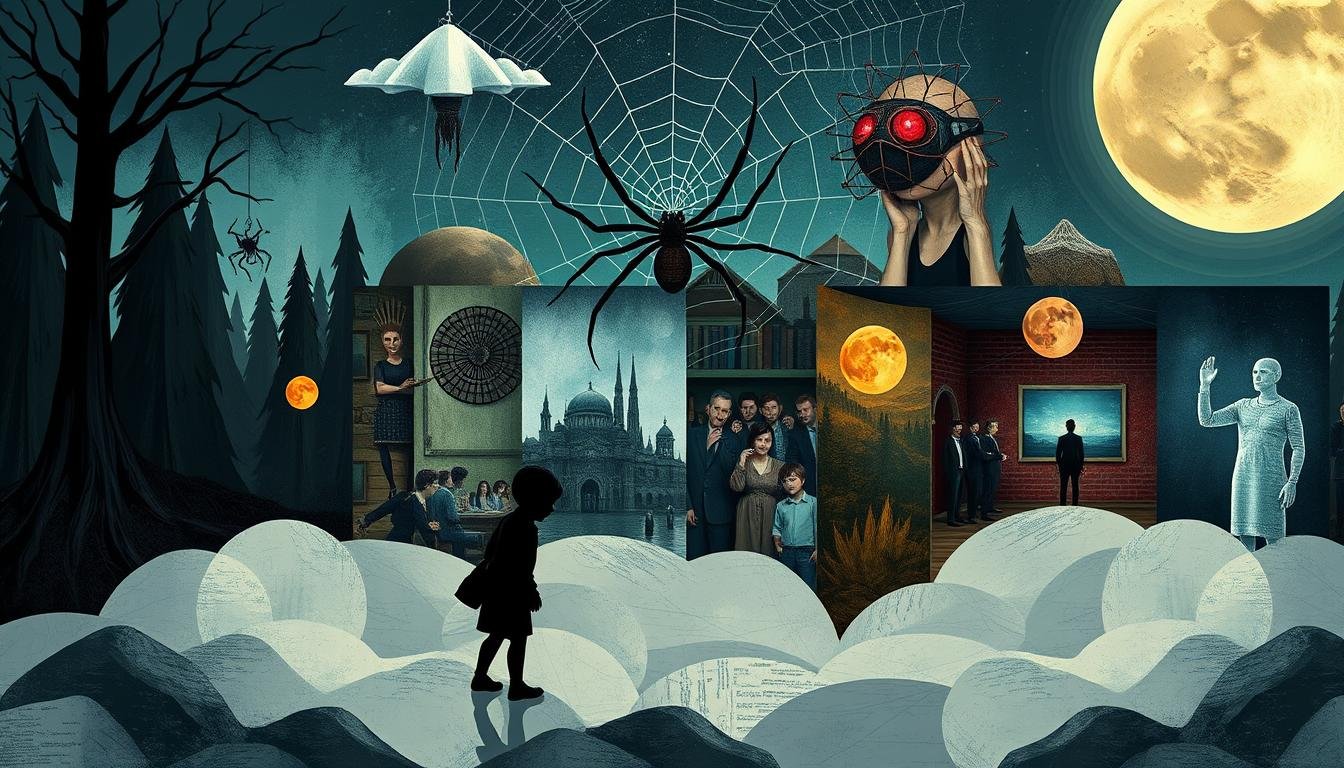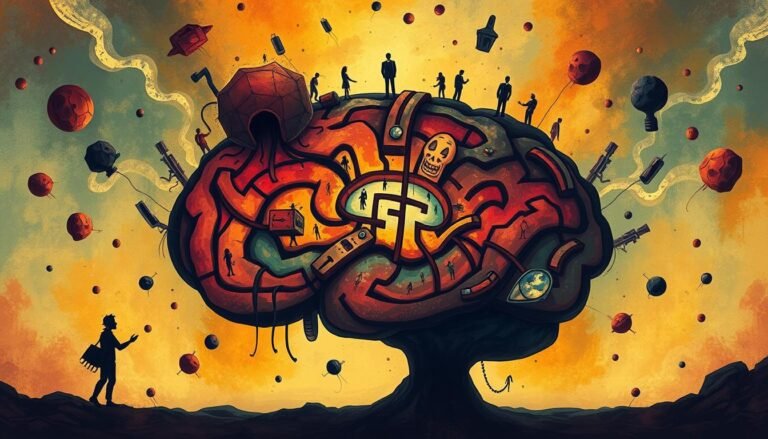Phobias: Understanding and Overcoming Fear
Ever felt your heart racing at the sight of a spider? Or found yourself unable to step onto a balcony? You’re not alone. Phobias affect millions, but what makes them different from normal fears?
Phobias are more than just fleeting worries. They’re intense, irrational fears that can disrupt daily life. Studies show that 9% to 13% of people experience a specific phobia at some point. These anxiety disorders can range from fear of animals to dread of certain situations.
Unlike normal fears, phobias cause overwhelming distress. A person with a dog phobia might avoid walking to school, fearing an encounter. Others might skip important events due to social anxiety. But there’s hope. Effective treatments exist, and many find relief through gradual exposure therapy.
This article dives into the world of phobias. We’ll explore their nature, origins, and impact on daily life. You’ll learn about common symptoms and triggers. Most importantly, we’ll discuss how to overcome these debilitating fears. Whether you’re struggling with a phobia or simply curious, read on to unravel the mystery of these powerful anxieties.
What Are Phobias?
Phobias are intense, irrational fears that affect millions worldwide. In the United States, about 19 million people deal with these fears. Unlike normal fears, phobias can severely impact daily life and cause extreme distress.
Defining Phobias vs. Normal Fears
Phobias are different from everyday fears because of their intensity and persistence. Normal fears are usually in line with the situation. But phobias trigger an exaggerated response to objects or scenarios that pose little real danger.
This overwhelming anxiety often leads to avoidance behaviors. It disrupts personal and professional life.
Common Types of Phobias
Phobias are categorized into three main types: specific phobias, social phobias, and agoraphobia. Specific phobias involve fear of particular objects or situations, like spiders or heights. Social phobias center around fear of social interactions or public scrutiny.
Agoraphobia, a complex phobia, involves fear of open or crowded spaces.
| Phobia Type | Description | Example |
|---|---|---|
| Specific Phobias | Fear of specific objects or situations | Claustrophobia (fear of enclosed spaces) |
| Social Phobias | Fear of social interactions | Glossophobia (fear of public speaking) |
| Agoraphobia | Fear of open or crowded spaces | Fear of leaving home or using public transportation |
Impact on Daily Life
Phobias can significantly affect a person’s quality of life. They may limit career opportunities, strain relationships, and lead to isolation. For instance, someone with social phobia might avoid important networking events.
A person with agoraphobia may struggle to leave their home. Understanding these impacts is crucial for recognizing the need for treatment and support.
Recognizing the signs and seeking help is essential. With proper treatment, including therapy and sometimes medication, most people can learn to manage their phobias effectively. They can regain control over their lives.
The Origins of Phobias
Phobias come from different places, like genetics and how our bodies are made to react to danger. Studies say 6-8% of people in Western countries and 2-4% in other parts of the world get specific phobias every year. Women are more likely to have phobias than men.
Genetics are a big part of getting phobias. Research shows that social anxiety and agoraphobia have a 50% genetic link. This means some people might be more likely to get these fears because of their genes.
Our body’s natural fear responses are shaped by evolution. For example, many people are afraid of spiders and snakes because our ancestors were. This fear is linked to the amygdala, a part of the brain that deals with fear.
“The amygdala plays a vital role in innate fear responses, activating when exposed to fearful faces or predator odors.”
Things around us can also make us develop phobias. This can happen through bad experiences, seeing others scared, or learning about scary things. Kids usually get specific phobias by age 10, but it can happen later too. When we face something we’re afraid of, it makes the amygdala work harder.
| Phobia Type | Prevalence | Key Factors |
|---|---|---|
| Specific Phobias | 6-8% in Western countries | Genetics, bad experiences |
| Social Phobia | 7% in the United States | Heritability, environmental influences |
| Agoraphobia | 1.7% globally | Genetic predisposition, learned behaviors |
Phobias: Recognizing Symptoms and Triggers
Phobias can show up in many ways, from mild anxiety to severe panic attacks. It’s key to know the physical and mental signs and common triggers for those affected and their families.
Physical Symptoms
People with phobias often have strong physical reactions when they face their fears. These can include:
- Rapid heartbeat
- Excessive sweating
- Trembling or shaking
- Shortness of breath
- Chest tightness
These signs are common in panic attacks, which can happen suddenly in phobic individuals.
Psychological Symptoms
The mental effects of phobias can be very distressing. Common mental symptoms include:
- Intense fear or dread
- Feeling of unreality
- Fear of losing control
- Overwhelming desire to escape
Common Phobia Triggers
Phobic triggers can vary a lot, depending on the fear. Some common ones are:
- Animals (e.g., spiders, dogs)
- Heights
- Enclosed spaces
- Social situations
- Medical procedures
Complex phobias, like agoraphobia and social phobia, can have many fears. They can really affect daily life. For example, agoraphobia might make someone afraid to leave their home. Social phobia might make someone avoid being in public.
Knowing these symptoms and triggers is the first step to dealing with phobias. With the right help and support, people can manage their fears and live better lives.
Effective Treatment Options for Phobias
Phobias can be tough to live with, but there’s good news. Many effective treatments can help people overcome their fears. Exposure therapy, a type of cognitive-behavioral therapy, is the gold standard for treating phobias. This method helps up to 90% of patients who stick with it.
In exposure therapy, you face your fears step by step in a safe setting. It’s like climbing a ladder, starting at the bottom and working your way up. This process of desensitization helps your brain learn that the feared object or situation isn’t as scary as you thought.
While therapy is key, some people might need extra help. Doctors sometimes prescribe medications like beta blockers or antidepressants to ease anxiety symptoms. But these aren’t long-term solutions. The best approach often combines therapy with self-help techniques like mindfulness and relaxation exercises.
Remember, seeking help is a sign of strength, not weakness. With the right treatment and support, most people can overcome their phobias and enjoy a fuller, less fearful life.
Source Links
- Understanding and overcoming phobias, with Martin Antony, PhD
- Fears and Phobias (for Teens)
- Phobias and Irrational Fears – HelpGuide.org
- Phobias: Symptoms, types, causes, and treatment
- The Most Common Phobias From A to Z
- Phobias
- Specific phobias – Symptoms and causes
- Neurobiology of fear and specific phobias
- Phobia
- Symptoms – Phobias
- Phobias: Causes, Types, Treatment, Symptoms & More
- Specific Phobias (Symptoms) | Center for the Treatment and Study of Anxiety
- Treatment – Phobias
- Treating Phobias
- Specific phobias – Diagnosis and treatment








